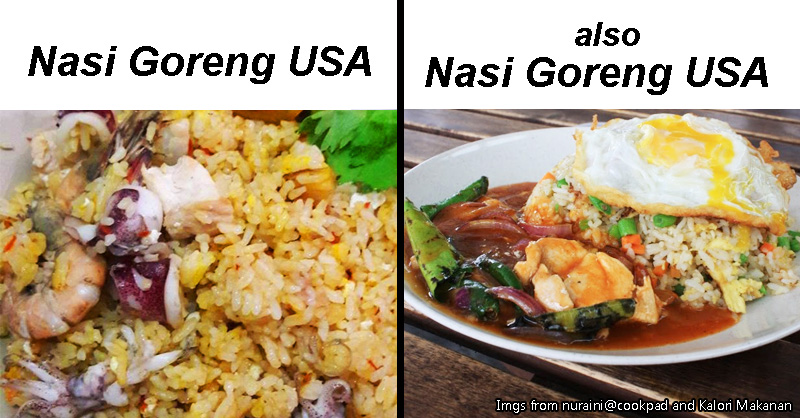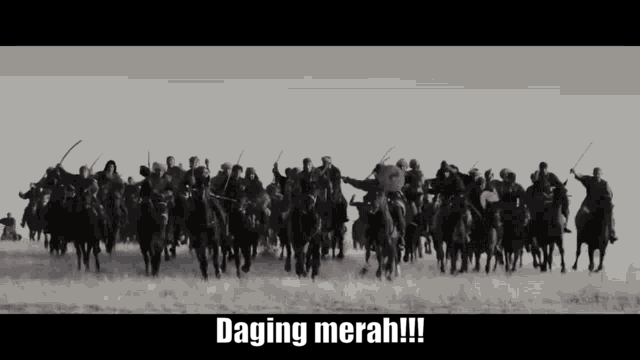There are two kinds of nasi goreng USA, but which one is correct?

- 191Shares
- Facebook162
- Twitter6
- LinkedIn6
- Email6
- WhatsApp10
War. War never changes. A bloody conflict recently flared up in the Cilisos office, and the trigger was a simple question: If you order a nasi goreng USA, what will you get?
Some insists that the ‘USA’ stands for Udang, Sotong and Ayam, so it will be a nasi goreng with bits of prawn, squid and chicken in it. Others maintain that if you ask any mamak for a nasi goreng USA, they will give you a plain fried rice, daging masak merah, and a telur mata on top. Chaos ensued, brother turned on brother, and many work hours were lost in the following conflict.

A temporary ceasefire was called, and it was decided that both sides will keep their stockpile of nerve agents locked up whilst more research was done. For starters, we asked our readers on Facebook…

…but it was inconclusive. Taking a leaf out of the Malaysian government’s book, both sides then agreed to form a fact-finding commission, appointing an ‘impartial group of people’ and paying them extra salary to seek the truth. And after three levels of subcontracting, six months of lazing around, and one hour of Googling, the Cilisos Inquiry into Nasi Goreng USA tested some hypotheses…
Theory #1: It’s the daging masak merah one, because similar to Thailand’s nasi goreng Amerika
The commission felt that since nasi goreng USA falls under Thai food, it must have a Thai dish from which it came, right? The closest equivalent we can think of would be khao pad American (lit American fried rice), which uses American ingredients like frozen mixed vegetables, spam, sausages, hot dogs, ham, raisins, butter, and basically whatever American food you can think of to make the rice and its side dishes.

It’s also noted that to cater to Americans during the Vietnam War era – when it was allegedly first invented – the flavorings for American fried rice are also different from the usual Thai fried rice: salt instead of fish sauce, and parsley instead of fresh coriander, for example.
However, comparing closely, the daging masak merah version of nasi goreng USA isn’t that close to khao pad American after all. Our version is a basic nasi goreng coupled with daging masak merah and crispy fried egg, all very Thai components. Also, this version of nasi goreng USA can hardly be called a separate dish on its own right: if you order nasi goreng daging merah (another popular Thai dish in Malaysia) with telur mata, you’ll get exactly the same thing.
So all things considered, the daging merah version’s sovereignty is unvalidated and highly unlikely. Which brings us to the second theory…
Theory #2: It’s a Malaysian invention with an unfortunately confusing name
Innovations to Thai food this side of the border isn’t unheard of. Case in point: the humble nasi goreng pattaya, a mass of fried rice covered in a thin omelette which, despite the name literally being a place in Thailand, is a purely Malaysian invention. And before we piss off the Indonesians, some Indonesian sites agree, as the Indonesian version for this dish is called nasi goreng amplop. Don’t attack us ar.

Anyways, we can’t find the legit documented origins of the udang sotong ayam version of nasi goreng USA, so we offer a theory: a Malaysian Thai chef putting all the usual, cheaper proteins into fried rice and coming up with a catchy acronym, giving birth to this creation. But that’s just our theory lah.
While the origins are unclear, we do know that Chef Wan (or at least his voice) did say that the USA in Nasi Goreng USA stands for Udang, Sotong, and Ayam, confirming that this is indeed the correct version of the dish. Cause we ain’t about to question Chef Wan.
Banyak nama-nama makanan yang guna nama tempat tetapi sebenarnya makanan tu tidak berasal dari tempat tu. Contohnya:
1. Nasi Goreng USA (Bukan dari Amerika, tapi USA untuk; Udang Sotong Ayam)
2. Mee Bandung (Tiada di Bandung, Indonesia)Siapa tahu nama-nama makanan lain lagi? pic.twitter.com/9TDqKkl1vg
— Les’ Copaque (@lescopaque) June 23, 2020
Case closed! So when the mamak brings you daging merah the next time you order a nasi goreng USA, feel free to be indignant about it and go ‘ackchually’ on his derrière. With this conflict resolved, the commission recommends that the war end immediately, and for all Cilisos staff seeking asylum at the nearby KK mart to return to the office immediately.
- 191Shares
- Facebook162
- Twitter6
- LinkedIn6
- Email6
- WhatsApp10
